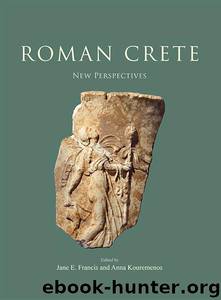roman crete by Jane E. Francis

Author:Jane E. Francis [Jane E. Francis]
Language: eng
Format: epub
Figure 9.2 The boar hunting scene, on the lekythos of Diopeithes (Athens, National Archaeological Museum, Θ352). Photo by K. Valtin von Eickstedt, © Hellenic Ministry of Culture and Sports/Archaeological Receipts Fund.
During Roman times, the number of renderings of the theme grows, and, though still inspired by Greek mythology, the boar is shown in various poses and compositions (LIMC 6, s.v. Meleagros, 426–7, nos 117–27, pls 220–2 [Woodford and Krauskopf]). Examples include reliefs showing boars dragging the chariot of Eros, Erotes chasing boars (Reinach 1909, 367:4; 1912, II, 99:1), a boar under attack by one of the Hyades (Ὑάδαι), apparently in revenge for the death of their brother Hyas (Reinach 1909, 174:3; Grimal 1991, 668), a boar as the prey of Artemis (Reinach 1909, 354:3), or as a decorative element on the side of an altar (Reinach 1912, II, 490:6). Depictions of actual hunting also occur in which the boar emerges from a tree cavity or is shown being chased (Reinach 1909, 387, 250:1). On the metal skyphos from the Boscoreale Treasure, the animal is seated among food and kitchenware (Reinach 1909, 89:3). At the same time, Meleager and the Calydonian Boar Hunt emerge as a particularly popular theme, mainly gracing marble sarcophagi from the early Antonine period (LIMC 6, s.v. Meleagros, 433–5, nos 115–24, pls 219–21 [Woodford and Krauskopf]; Koch et al. 1975). The wide-ranging popularity of this theme for sarcophagus decoration is also observed on Crete: an Attic sarcophagus fragment of the first half of the 3rd century AD found at Lissos displays the motif (Katakis 2012, 419–23).
The boar of Kissamos, therefore, is not a product of innovation in either its style or composition, but repeats well-established iconographic elements of the Classical past. This tendency is found in other plastic works of this period in Crete; for example, the Peplophoros statue exhibited in the Herakleion Archaeological Museum, which also comes from Kissamos (Karanastasi 2012, 437–9; this volume). Moreover, the apparent Attic origin of its marble, the conservative character of its composition, and primarily the classicizing rendering of the iconographic type of the depicted animal, all lead us towards Attica of the 2nd century AD. This period, especially during the reign of Hadrian and until the third quarter of the 3rd century AD, is marked by a keen interest in the products of Attic sculptural workshops that followed the artistic standards of the past or were inspired by them (Tiveriou 1993, 210–3), a style also known as Neo-Attic (Fuchs 1959; Pollitt 1994, 221–6, Cain and Dräger 1994). The increase in demand for copies resulted in the establishment of large sculpture workshops in Attica employing numerous craftsmen. The Neo-Attic reliefs of Piraeus are also similar products of mass production from these workshops, even though they never reached their destination. Alongside the copies and Neo-Attic creations, this period is marked as well by a systematic production by the same Attic workshops of marble sarcophagi and one-legged table supports with plastic decoration, all showing significant compositional and stylistic similarities (Tiveriou 1993, 213–22). These
Download
This site does not store any files on its server. We only index and link to content provided by other sites. Please contact the content providers to delete copyright contents if any and email us, we'll remove relevant links or contents immediately.
| Africa | Americas |
| Arctic & Antarctica | Asia |
| Australia & Oceania | Europe |
| Middle East | Russia |
| United States | World |
| Ancient Civilizations | Military |
| Historical Study & Educational Resources |
The Daily Stoic by Holiday Ryan & Hanselman Stephen(3110)
The Fate of Rome: Climate, Disease, and the End of an Empire (The Princeton History of the Ancient World) by Kyle Harper(2874)
People of the Earth: An Introduction to World Prehistory by Dr. Brian Fagan & Nadia Durrani(2619)
Ancient Worlds by Michael Scott(2493)
Babylon's Ark by Lawrence Anthony(2433)
Foreign Devils on the Silk Road: The Search for the Lost Treasures of Central Asia by Peter Hopkirk(2388)
The Daily Stoic by Ryan Holiday & Stephen Hanselman(2344)
India's Ancient Past by R.S. Sharma(2298)
MOSES THE EGYPTIAN by Jan Assmann(2275)
The Complete Dead Sea Scrolls in English (7th Edition) (Penguin Classics) by Geza Vermes(2135)
Lost Technologies of Ancient Egypt by Christopher Dunn(2111)
The Earth Chronicles Handbook by Zecharia Sitchin(2101)
24 Hours in Ancient Rome by Philip Matyszak(1973)
Alexander the Great by Philip Freeman(1961)
Aztec by Gary Jennings(1879)
The Nine Waves of Creation by Carl Johan Calleman(1784)
Curse Tablets and Binding Spells from the Ancient World by Gager John G.;(1768)
Before Atlantis by Frank Joseph(1740)
Earthmare: The Lost Book of Wars by Cergat(1715)
